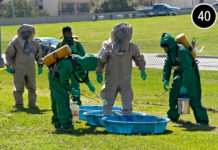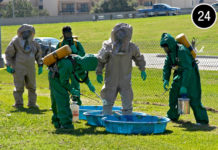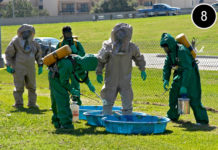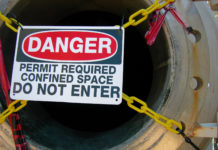Snow removal operations can result in serious injuries or fatalities — particularly while removing ice or snow from rooftops and other building structures such as decks. Understanding these serious hazards, OSHA has a pamphlet for employers and workers involved in snow and ice removal activities.
Know Your Rights. Under federal law, you are entitled to a safe workplace and your employer is responsible for your safety.
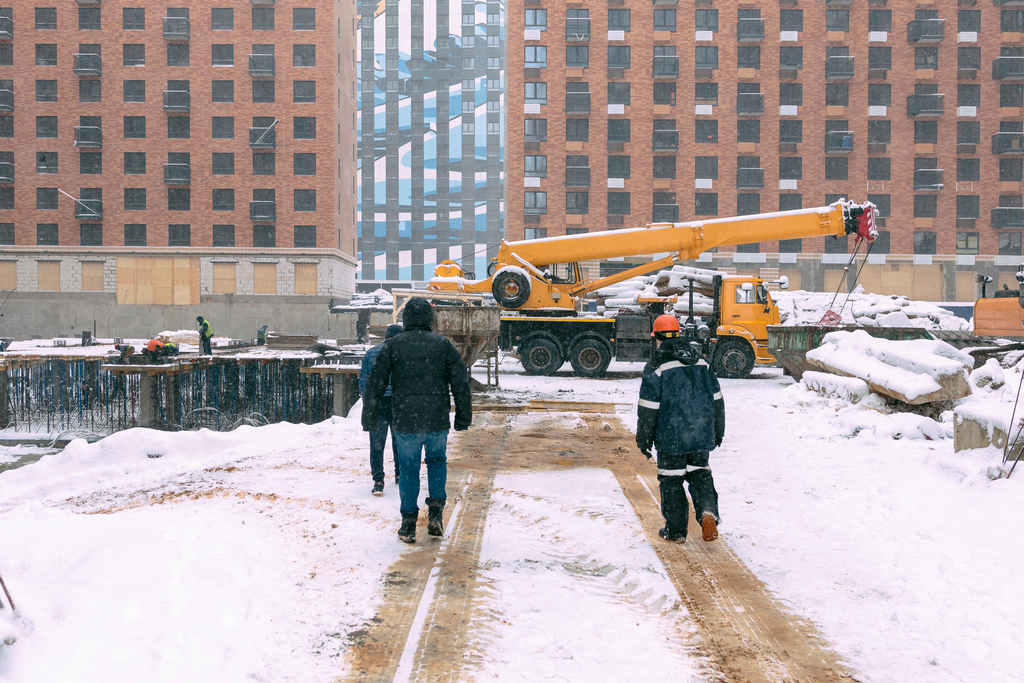
According to the OSHA pamphlet, falls are the leading cause of injuries and fatalities among workers who remove ice and snow from rooftops and other structures. Workers can fall off roof edges, through skylights, and from ladders and aerial lifts and a roof collapse can also hurt or fatally injure workers.
Other hazards include frostbite and hypothermia; back injuries from slips, trips, falls or overexertion; falling ice; shock or electrocution from power lines or extension cords; and aerial lift collapses or tip-overs.
- Training provides an overview of OSHA, workplace hazards, workers' rights, employer responsibilities, and how to file a complaint. Required by some states and companies in order to start employment on a worksite.
- 10hr only $89 - 30hr only $169!
- Enter Promo Code "osha15offF" at Checkout
Snow Removal – Before Work Begins
- Plan ahead for safe snow removal from roofs.
- Check the worksite for workplace hazards.
- Limit, when and where possible, workers going on roofs to remove snow.
- Use snow removal procedures that lower the risk of roof or structure collapse.
- Ensure that workers follow all manufacturers’ instructions for using mechanical equipment safely.
Snow Removal – Employer Responsibilities
According to federal law, a worker has the right to:
- Working conditions that do not pose a risk of serious harm.
- Receive information and training (in a language and vocabulary you understand) about workplace hazards, methods to prevent them, and the OSHA standards that apply to their workplace.
Before any work begins, employers must:
- Train workers to identify fall and electrical hazards.
- Train workers on appropriate protective equipment, fall prevention, and electrical standards. See 29 CFR 1910 Subparts D, F, I and S.
- Provide fall protection equipment (29 CFR 1910.23 – Ladders, 1926.501 – Fall Protection) that is in good working condition.
- Train workers to use ladders, aerial lifts and protective equipment, per manufacturers’ guidelines.
- Have a plan for rescuing a worker caught by a fall protection system.
Snow Removal: Know the Hazards – Pamphlet
(OSHA 3966 – 2019) (English: PDF)
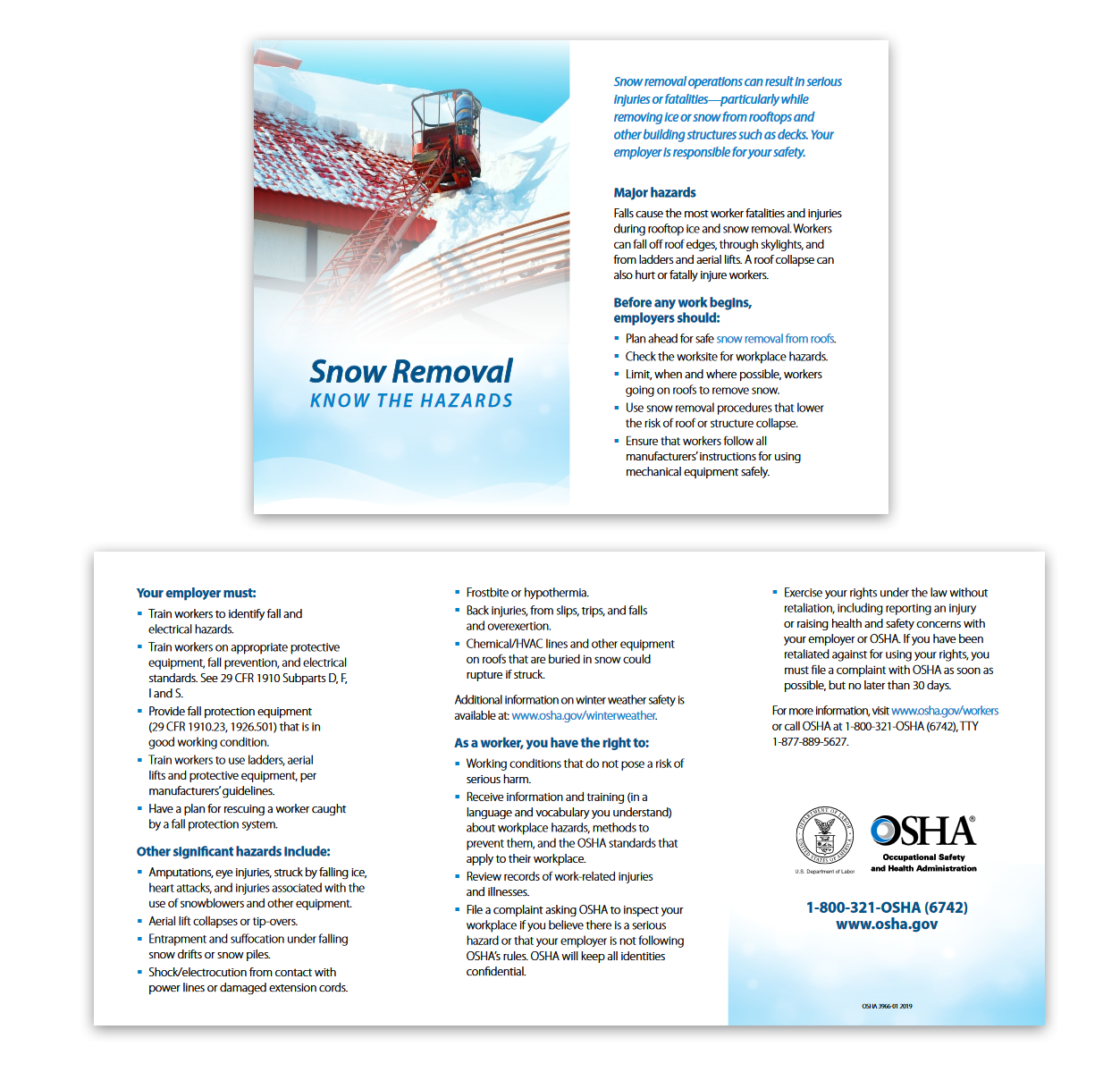
Cold Stress Safety Tips for Workers
When cold environments cannot be avoided, workers should follow these recommendations to protect themselves from cold stress:
- Wear appropriate clothing.
- Wear several layers of loose clothing. Layering provides better insulation.
- Tight clothing reduces blood circulation. Warm blood needs to be circulated to the extremities.
- When choosing clothing, be aware that some clothing may restrict movement resulting in a hazardous situation.
- Make sure to protect the ears, face, hands and feet in extremely cold weather.
- Boots should be waterproof and insulated.
- Wear a hat; it will keep your whole body warmer. (Hats reduce the amount of body heat that escapes from your head.)
- Move into warm locations during work breaks; limit the amount of time outside on extremely cold days.
- Carry cold weather gear, such as extra socks, gloves, hats, jacket, blankets, a change of clothes and a thermos of hot liquid.
- Include a thermometer and chemical hot packs in your first aid kit.
- Avoid touching cold metal surfaces with bare skin.
- Monitor your physical condition and that of your coworkers.

What are the most common cold induced illnesses/injuries?
- Hypothermia
- Frostbite
- Trench Foot
Some of the risk factors that contribute to cold stress are:
- Wetness/dampness, dressing improperly, and exhaustion;
- Predisposing health conditions such as hypertension, hypothyroidism, and diabetes;
- Poor physical conditioning.
Hypothermia
What is hypothermia?
Hypothermia occurs when body heat is lost faster than it can be replaced and the normal body temperature (98.6°F) drops to less than 95°F. Hypothermia is most likely at very cold temperatures, but it can occur even at cool temperatures (above 40°F), if a person becomes chilled from rain, sweat, or submersion in cold water.
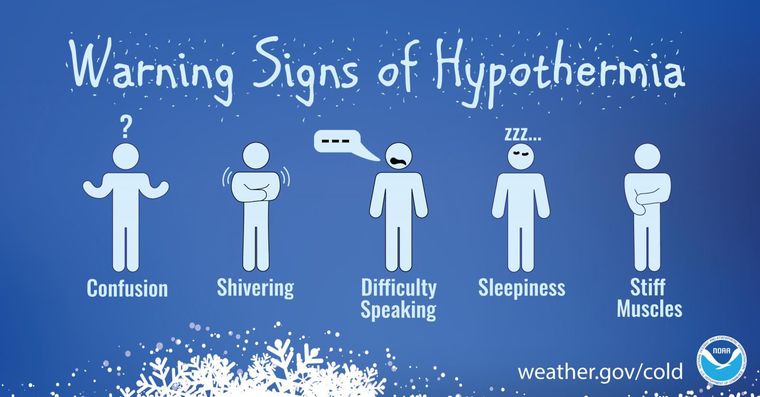
What are the symptoms of hypothermia?
- Mild symptoms:
- An exposed worker is alert.
- He or she may begin to shiver and stomp the feet in order to generate heat.
- Moderate to Severe symptoms:
- As the body temperature continues to fall, symptoms will worsen and shivering will stop.
- The worker may lose coordination and fumble with items in the hand, become confused and disoriented
- He or she may be unable to walk or stand, pupils become dilated, pulse and breathing become slowed, and loss of consciousness can occur. A person could die if help is not received immediately.
What can be done for a person suffering from hypothermia?
- Call 911 immediately in an emergency; otherwise seek medical assistance as soon as possible.
- Move the person to a warm, dry area.
- Remove wet clothes and replace with dry clothes, cover the body (including the head and neck) with layers of blankets; and with a vapor barrier (e.g. tarp, garbage bag). Do not cover the face.
- If medical help is more than 30 minutes away:
- Give warm sweetened drinks if alert (no alcohol), to help increase the body temperature. Never try to give a drink to an unconscious person.
- Place warm bottles or hot packs in armpits, sides of chest, and groin. Call 911 for additional rewarming instructions.
- If a person is not breathing or has no pulse:
- Call 911 for emergency medical assistance immediately.
- Treat the worker as per instructions for hypothermia, but be very careful and do not try to give an unconscious person fluids.
- Check him/her for signs of breathing and for a pulse. Check for 60 seconds.
- If after 60 seconds the affected worker is not breathing and does not have a pulse, trained workers may start rescue breaths for 3 minutes.
- Recheck for breathing and pulse, check for 60 seconds.
- If the worker is still not breathing and has no pulse, continue rescue breathing.
- Only start chest compressions per the direction of the 911 operator or emergency medical services*
- Reassess patient’s physical status periodically.
*Chest compression are recommended only if the patient will not receive medical care within 3 hours.
Frostbite
What is frostbite?
Frostbite is an injury to the body that is caused by freezing of the skin and underlying tissues. The lower the temperature, the more quickly frostbite will occur. Frostbite typically affects the extremities, particularly the feet and hands. Amputation may be required in severe cases.
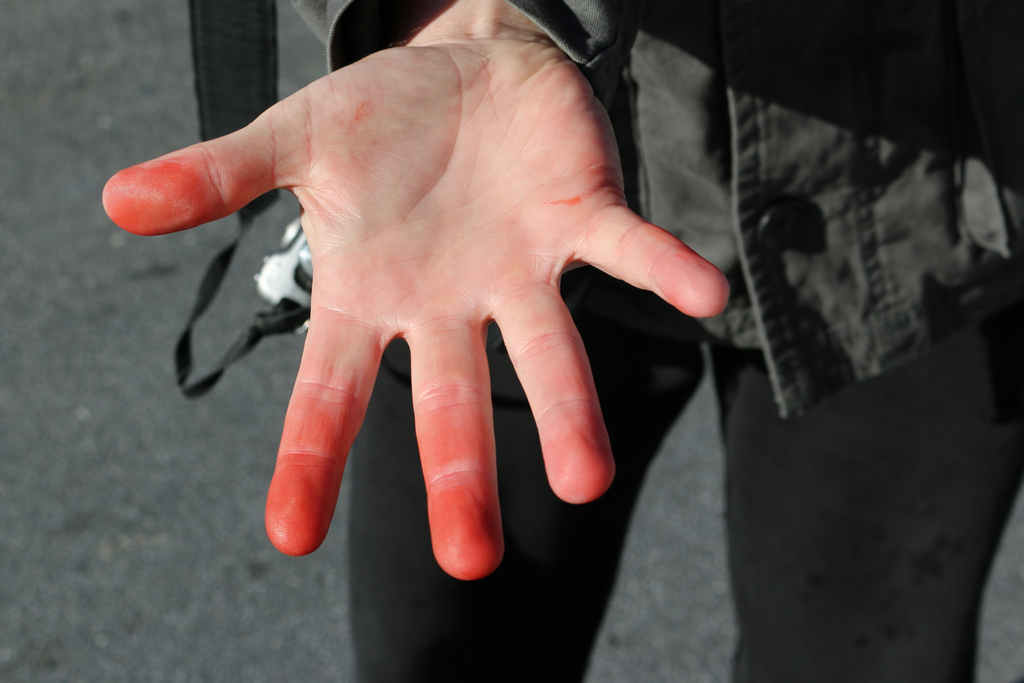
What are the symptoms of frostbite?
- Reddened skin develops gray/white patches.
- Numbness in the affected part.
- Feels firm or hard.
- Blisters may occur in the affected part, in severe cases.
What can be done for a person suffering from frostbite?
- Follow the recommendations described above for hypothermia.
- Do not rub the affected area to warm it because this action can cause more damage.
- Do not apply snow/water. Do not break blisters.
- Loosely cover and protect the area from contact.
- Do not try to rewarm the frostbitten area before getting medical help; for example, do not place in warm water. If a frostbitten area is rewarmed and gets frozen again, more tissue damage will occur. It is safer for the frostbitten area to be rewarmed by medical professionals.
- Give warm sweetened drinks, if the person is alert. Avoid drinks with alcohol.
Trench Foot
What is immersion/trench foot?
Trench Foot or immersion foot is caused by prolonged exposure to wet and cold temperatures. It can occur at temperatures as high as 60°F if the feet are constantly wet. Non-freezing injury occurs because wet feet lose heat 25-times faster than dry feet. To prevent heat loss, the body constricts the blood vessels to shut down circulation in the feet. The skin tissue begins to die because of a lack of oxygen and nutrients and due to the buildup of toxic products.
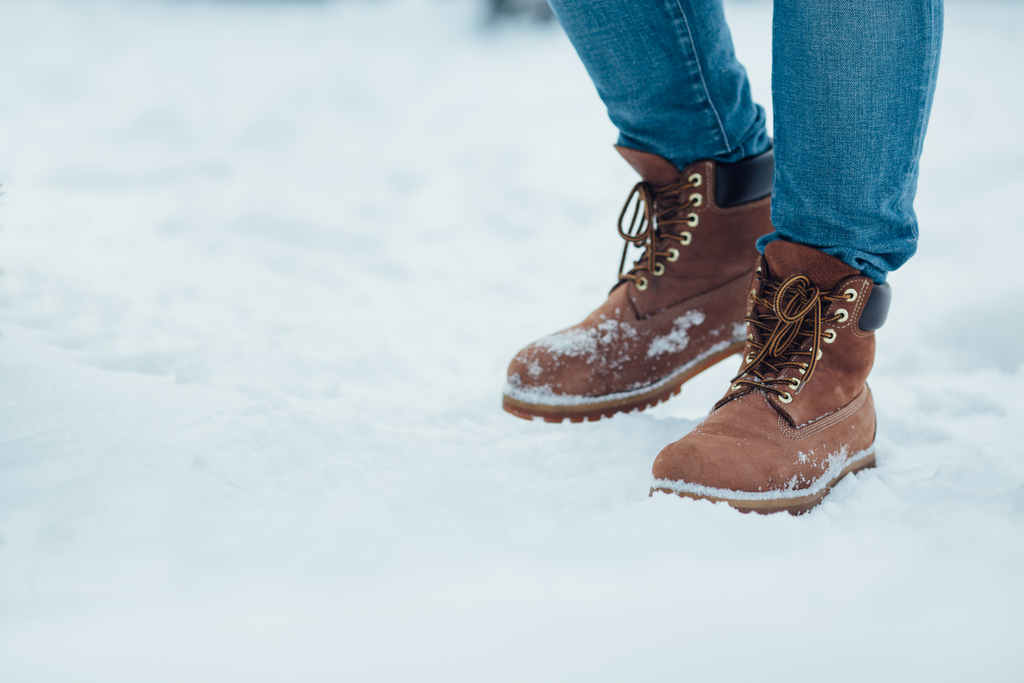
What are the symptoms of trench foot?
- Redness of the skin, swelling, numbness, blisters
What can be done for a person suffering from immersion foot?
- Call 911 immediately in an emergency; otherwise seek medical assistance as soon as possible.
- Remove the shoes, or boots, and wet socks.
- Dry the feet.
Wind Chill Temperatures
Wind Chill is the term used to describe the rate of heat loss from the human body, resulting from the combined effect of low air temperature, and wind speed. The Wind Chill Temperature is a single value that takes both air temperature, and wind speed into account. For example, when the air temperature is 40°F, and the wind speed is 35mph, the wind chill temperature is 28°F; this measurement is the actual effect of the environmental cold on the exposed skin.
National Weather Service (NWS) Wind Chill Calculator: With this tool, one may input the air temperature and wind speed, and it will calculate the wind chill temperature.
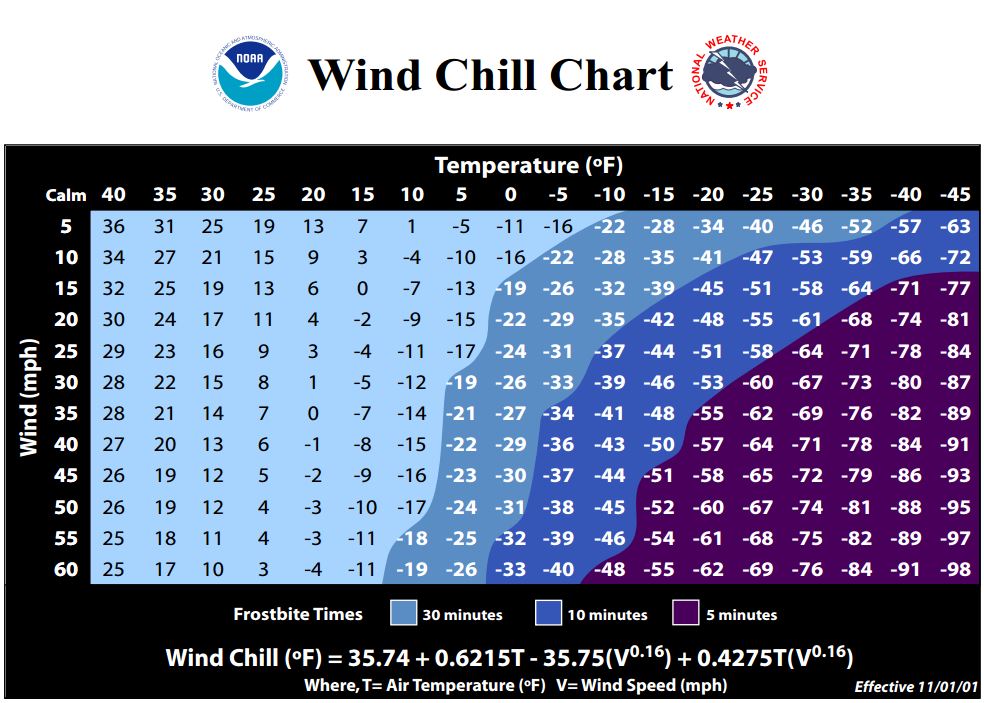
Dressing Properly for Extreme Cold
Dressing properly is extremely important to preventing cold stress. The type of fabric worn also makes a difference. Cotton loses its insulation value when it becomes wet. Wool, silk and most synthetics, on the other hand, retain their insulation even when wet. The following are recommendations for working in cold environments:
- Wear at least three layers of loose fitting clothing. Layering provides better insulation. Do not wear tight fitting clothing.
- An inner layer of wool, silk or synthetic to keep moisture away from the body.
- A middle layer of wool or synthetic to provide insulation even when wet.
- An outer wind and rain protection layer that allows some ventilation to prevent overheating.
- Wear a hat or hood to help keep your whole body warmer. Hats reduce the amount of body heat that escapes from your head.
- Use a knit mask to cover the face and mouth (if needed).
- Use insulated gloves to protect the hands (water resistant if necessary).
- Wear insulated and waterproof boots (or other footwear).
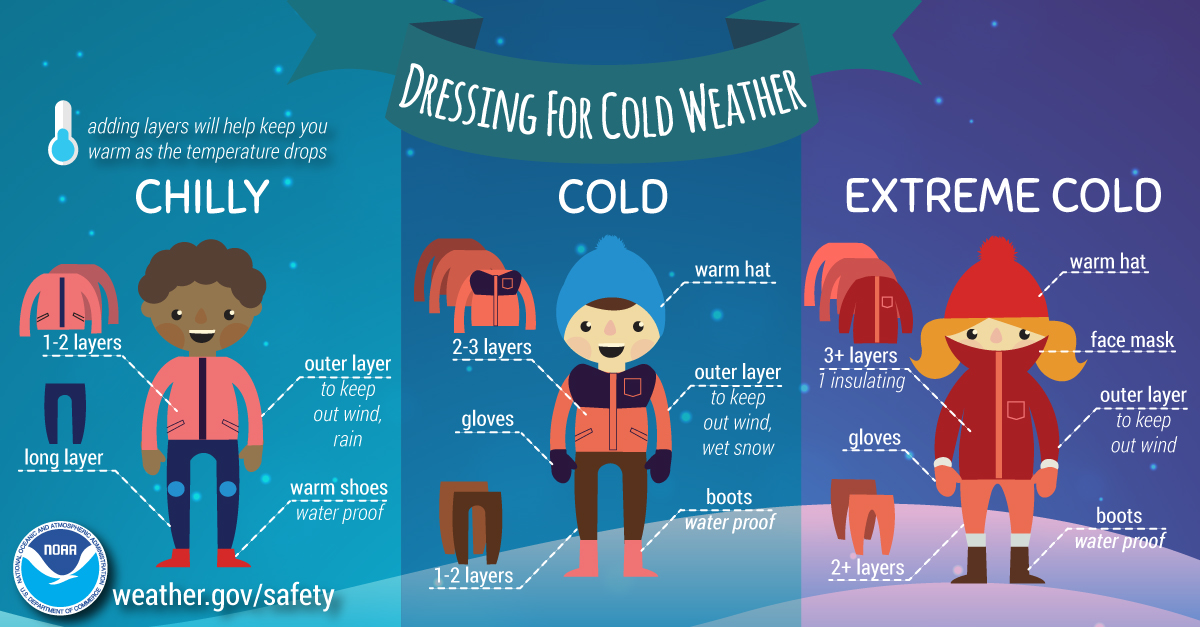
Additional Cold Stress Resources
- NIOSH – Protecting Yourself from Cold Stress – Learn all about working in the cold. (PDF)
- Cold Stress. CDC
- Cold Stress QuickCard Revised
(OSHA 3156 – 2014) (English: PDF )
(OSHA 3158 – 2015) (Spanish: PDF) - Snow Removal: Falls and Other Hazards to Workers Removing Snow from Rooftops and Other Elevated Surfaces
(OSHA 3513 – 2012) (English: HTML PDF) - Snow Removal: Know the Hazards Pamphlet NEW
(OSHA 3966 – 2019) (English: PDF)







